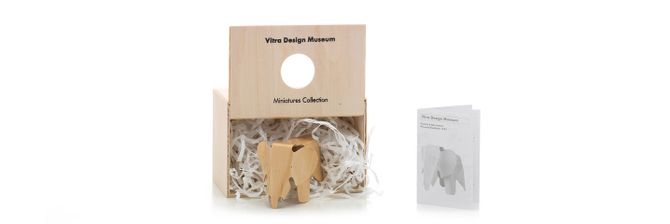
Miniatures Plywood Elephant natur
Charles & Ray Eames, 1945
Designed at the same time as their children's furniture, the Plywood Elephant can also be seen as a playful counterpart to the leg splints developed by the Eameses for military applications – which were the very first mass-produced objects made of threedimensionally moulded plywood.
Requiring complex fabrication methods, the Plywood Elephant never went into production. Only two prototypes were made, both of which were displayed at the New York Museumof Modern Art in 1945-46. Today only one known model remains in the possession of the Eames Family. In 2007 Vitra produced the first commercial production of the legendary Eames Plywood Elephant as a limited Collector's Edition.
Information
- Scale: 1:6, 130 x 69 x 69 mm
- Material: Three-dimensionally moulded plywood, natural maple, nickle plated screw
Miniatures Collection
For over two decades, the Vitra Design Museum has been making miniature replicas of milestones in furniture design from its collection. The Miniatures Collection encapsulates the entire history of industrial furniture design – moving from Historicism and Art Nouveau to the Bauhaus and New Objectivity, from Radical Design and Postmodernism all the way up to the present day. Exactly one sixth the size of the historical originals, the chairs are all true to scale and precisely recreate the smallest details of construction, material and colour. The high standard of authenticity even extends to the natural grain of the wood, the reproduction of screws and the elaborate handicraft techniques involved. This has made the miniatures into popular collector's items as well as ideal illustrative material for universities, design schools and architects.